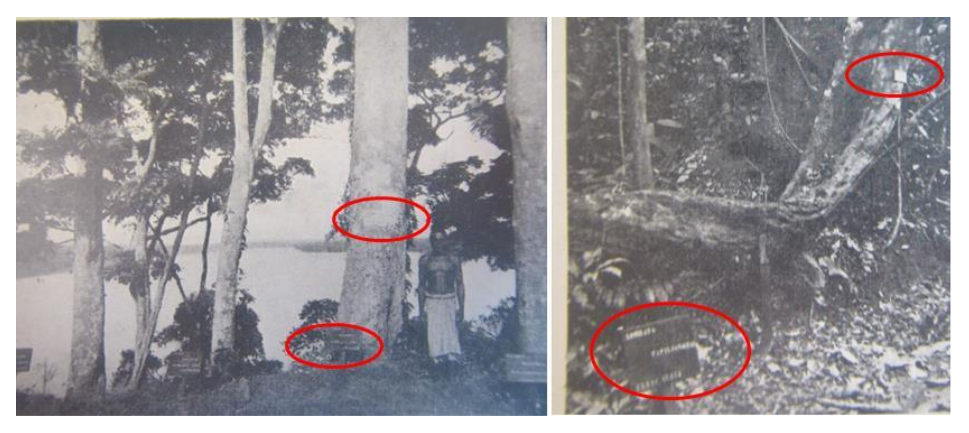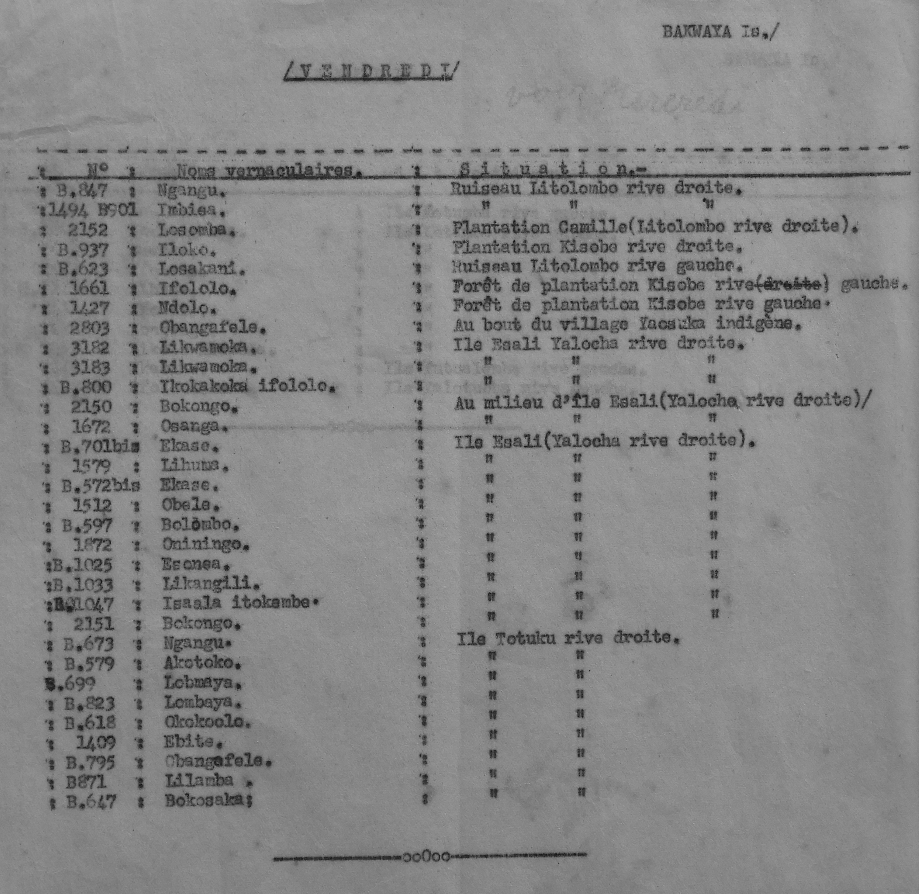Sampling protocol
The forestry division of the INEAC was created to study densily forested areas both in the central Congo Basin and the coastal Mayombe forests in a number of INEAC centers, in particular, in Yangambi and Luki, and to a lesser extent in the other centers. At all the centers the study of the forest flora, the establishment of scientific collections (exsiccata, seeds, seedlings, wood, enemies and diseases), the observation of the rhythmic phenomena (phenology), dendrochronological and wood biology studies and the study of forest stands was central. Overall some fifteen thousand trees were regularly observed for months up to decades (witboek).
At Yangambi observations of (tree) phenology were made on a weekly schedule (Monday to Saturday), grouping trees by geographic region. Trees were flagged with bright (white) blazes and metal ID plaques (Figure 1), and observed by locally trained personnel familiar with the vegetation. Unlike studies using a similar protocol at the Luki reserve no remaining metal tags could be found on site (de Mill personal communications). Irrespective of the lack of metal markers some trees were found through detailed descriptions of their location. From these recovered historical descriptions we determined that every observer would observe roughly ~132 ± 52 trees per day along their phenological route.
In total ~6000 still growing trees and lianas across ~600 species were observed for phenological purposes (Capon 1947). These obervations include the timing of flowering, fruit development and dispersion and leaf drop. The emphasis on species changed over time when observations were transferred from the botanical division (Division Botanique) to the forestry department (Division Foresterie), which retained mostly commercial species toward the end of the observation period. Many trees with observations before 1937 were cut for wood biological studies and received a database number (Tw) for the collection of Louis (appendix A). These changes over time through anthropogenic or natural causes are noted by both the non sequential nature of trees in the weekly planning (Figure 2) and the recovered data values.
The observed plants covered the wide Yangambi region from the islands in the Congo river to the plateau to the north of Yangambi (Figure 2). We identified nine key areas, mainly (1) Parc Isalowe (“Parc Forestier”), (2) along the river Isalowe, (3) around the building of the forestry division, (4) at the phyto-technical department (current abandoned buildings of the IFA), (5) near experimental sites, (6) along the river Lusambilla, (7) along roads to Yangambi from Kisangani, Isangi or NGasi (“Arbres eloignees” or far removed trees) (8) on islands of the Congo river, and (9) in front of the Yangambi reserve (Tofende, Lomondje, Tutuku, Esali). This wide distribution has considerable importances with respect to phenology as it mediates both soil properties and water availability during the dry season.
Observations of fruiting were limited to those species which drop fruit. Capon (1947) acknowledges that observations near water or fruits desirable by humans or animals (in large quantities) might be biased. Similarly, Capon further notices that spotting flowers on larger trees took considerable practice where to author felt skilled after observing roughly 3000 trees in various circumstances. In this early study by Capon geographic differences were already noted. For example, Lannea Welwitschii fruits appeared continuously on the islands in the Congo river, while on a far longer cycle in other locations.
References
Witboek/Livre blanc - wetenschappelijke bijdrage van België tot de ontwikkeling van Centraal-Afrika - apport scientifique de la Belgique au développement de l’Afrique centrale, 2. Sciences naturelles et médicales / Natuur- en Geneeskundige Wetenschappen. (506-956-XVI pp., 1962)